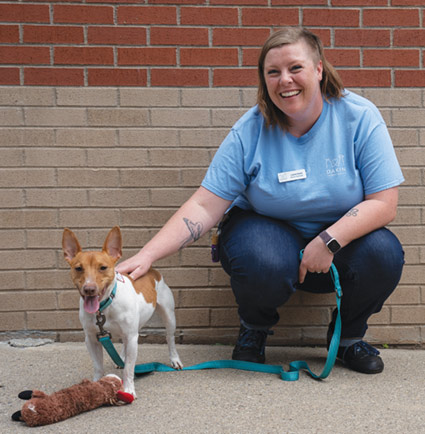
By Lee Chambers
Media Relations and Development Specialist for Dakin Humane Society
Lauren Rubin, KPA, CTP, CPDT-KA, FFCP, has been Dakin Humane Society’s behavior coordinator for nearly two years. She evaluates dogs for intake and adoption, trains dog care volunteers, assists the public with training advice and provides enrichment and care for the dogs at Dakin to keep them mentally healthy and happy.
Prime asked Lauren her advice on some common dog training issues. Here’s what she shared with readers:
Q: Everyone wants their new pet to have a good start in the family. What are some basics help to teach a new puppy good behavior?
“The biggest mistake people make when they get a new puppy is they think ‘you’re small and cute, so I’m going to let you get to do stuff I wouldn’t let a large dog do.’
“Every time your puppy does something, envision them at their adult size and ask yourself, ‘Is this something I will still find cute and precious when you’re eight months old and weigh 50 pounds?’ If not, we need to stop that behavior right now.
“If your puppy is chewing on something you don’t want them to chew on, limit their access to it. The other thing that’s really important with puppies, is when you see them doing something that you like, praise them. Give them a treat. People tend to ignore good behavior and punish bad behavior, and that’s a huge mistake. If your puppy is doing nothing, just lying there quietly, tell them “Good dog! Have a treat!”
Q: When asked what is one of the most problematic behaviors, many dog owners cite excessive barking. Do you have tips to help pet parents cope with this common problem?
“The first thing to think about is why is your dog barking? And that generally falls into two or three categories. One of them is ‘I learned as a puppy that if I yell at you long enough, you’ll give me what I want,’ which is now a trained behavior. Another is ‘I am not getting enough stimulation and I’m bored, so I’m just listening to the sound of my own voice,’ and the other is alert barking.
“ For the first two categories, those can be managed by increasing exercise and activity, and getting ahead of the barking behavior. For example, if I feed my dog at 6 p.m., and my dog starts barking at 5:45 p.m., I want to get ahead of him and start feeding him at random times before 6 p.m. If it’s slightly unpredictable, he can’t set his watch to it. For dogs that are bored, give them something to do to get ahead of it.
“For dogs that alert bark, which means barking at a car or person going by, you can put on ‘white noise’ sound machines. Your dog will still hear things, but it blends in better into the background. The other thing is visual barriers. If your dog can see people walking by through the window, pull the curtains, move furniture away from windows so they can’t climb up on the furniture and yell.”
Q: Another problem cited by several dog owners is aggressive behavior when receiving treats, or food in general. Are there strategies to help pets learn to approach their treats and meals in a calmer manner?
“If you are concerned that your dog is attempting to hurt you versus accidentally hurting you, if they’re attempting to hurt you in an effort to protect their food, you need to contact a trainer.
“If you’re talking about a dog who is getting too excited about a treat and can’t stop themselves, these tips will help.
“Again, we’re talking about dogs who are a little mouthy or rough when taking food or treats from your hand. When you go to feed the treat gently, you’re going to want to pinch the treat between your fingers so your fingernails are the first thing your dog’s mouth comes into contact with. You’re going to hold the treat until their mouth is soft, that is, until you feel their lips and not their teeth. If you feel the teeth first, and they’re nibbling, keep the treat in your hand behind your fingers. Then when you feel their lips and not teeth, tell them “Good!” and release the treat.
“ If that hurts too much, you can offer the treat in your open palm, but if you see them winding up with what we call a “gator snap,” you pull the treat away. Try again, and pull it away if they do it again.”